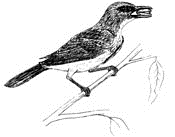Vertebrate Pest Conference: Proceedings

Vertebrate Pest Conference Proceedings: 17th (1996)
Date of this Version
1996
Document Type
Article
Citation
Published in Proceedings: Seventeenth Vertebrate Pest Conference … 1996, ed. Robert M. Timm & A. Charles Crabb (University of California, Davis, 1996).
Abstract
The impact of introduced commensal rodents on island flora has been relatively little studied compared with their impact on the fauna. The effects on vegetation composition, regeneration, and decomposition are largely unknown, but potentially great. Preliminary studies were carried out in the Galapagos Islands between 1993 and 1994 on the diet of introduced rats, Rattus spp. and feral house mice, Mus musculus, seed recovery rates and subsequent germination rates of seeds. R. rattus diet was primarily vegetation and 48% of rats had seeds in their stomachs. Significant differences were found between body size and overall contribution of both vegetable and animal foods, larger rats eating proportionately more animal foods and less vegetable. There was no significant difference between the sexes in terms of main dietary components. There was no significant difference in the selection of food types between R. rattus and R. norvegicus, both species tended to prefer banana and avocado, and only rats from the Miconia zones showed a preference for Miconia berries. No intact seeds were found in the stomachs of feral house mice from the same sites. Recovered seeds of two native and two introduced plant species were successfully germinated under laboratory conditions. R. norvegicus is potentially a better dispersal agent for seeds as it has a greater tendency to ingest them intact. The implications of these findings for the conservation of island flora are discussed.
Included in
Animal Sciences Commons, Bioresource and Agricultural Engineering Commons, Environmental Engineering Commons


Comments
Copyright © 1996 (where applicable) by the Vertebrate Pest Council of the Vertebrate Pest Conference. Used by permission.